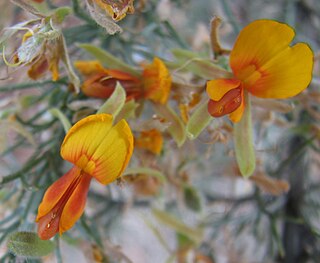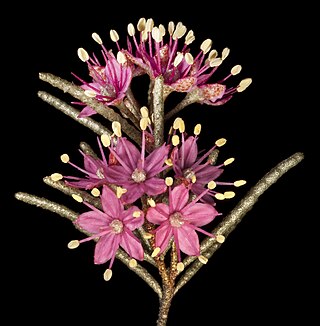
Darwinia, sometimes commonly known as mountain bells or simply bells, is a genus of about 70 species of evergreen shrubs in the family Myrtaceae, endemic to southeastern and southwestern Australia. The majority are native to southern Western Australia, but a few species occur in South Australia, New South Wales and Victoria. The genus was named in honour of Erasmus Darwin, grandfather of Charles Darwin by Edward Rudge in 1816. Most darwinias grow to a height of between 0.2 and 3 m, and many are prostrate shrubs. Most have small, simple leaves and the flowers are often grouped together, each flower with five red, white or greenish petals and ten stamens. In many species, the flowers are surrounded by large, colourful bracts, giving rise to their common names.

Kunzea is a genus of plants in the family Myrtaceae and is endemic to Australasia. They are shrubs, sometimes small trees and usually have small, crowded, rather aromatic leaves. The flowers are similar to those of plants in the genus Leptospermum but differ in having stamens that are longer than the petals. Most kunzeas are endemic to Western Australia but a few occur in eastern Australia and a few are found in New Zealand. The taxonomy of the genus is not settled and is complicated by the existence of a number of hybrids.

Baeckea is a genus of flowering plants in the myrtle family, Myrtaceae, all but one endemic to Australia. Plants in the genus Baeckea are shrubs or small trees with leaves arranged in opposite pairs, white to deep pink flowers with five sepals and five petals, and five to fifteen stamens that are shorter than the petals.

Beaufortia is a genus of woody shrubs and small trees in the family Myrtaceae and is endemic to Southwest Australia. The genus Beaufortia is closely related to Melaleuca, Calothamnus, Regelia and several others, differing mainly in the way the anthers are attached to the stalks of the stamens, and in the way they open to release their pollen. Beaufortia anthers are attached at one end and open by splitting at the other.

Chamelaucium uncinatum, the Geraldton waxflower, Geraldton wax, is a flowering plant endemic to Western Australia. It is an erect shrub 0.5 to 4m high, bearing white or pink flowers June–November. The name uncinatum means "hooked" in Latin, in reference to the tips of the leaves.

Mirbelia is a plant genus belonging to the family Fabaceae and is endemic to Australia, occurring in every mainland state except South Australia. Plants in the genus Mirbelia are prickly, perennial shrubs with simple, sometimes sharply-pointed leaves, or the leaves absent. The flowers are arranged singly or in groups in leaf axils or on the ends of branches, the sepals joined at the base with five teeth. The petals are usually red, orange, purplish or bluish and the fruit is an inflated pod.

Thryptomene is a genus of flowering plants in the family Myrtaceae and is endemic to Australia. Plants in the genus Thryptomene are shrubs with small leaves arranged in opposite pairs and white or pink flowers. About forty-seven species of Thryptomene, occurring in all Australian states and the Northern Territory, have been formally described.

Jacksonia is a genus of about 73 species of mostly leafless, broom-like shrubs or small trees in the flowering plant family Fabaceae. The genus is endemic to Australia and species occur in a range of habitats in all Australian states except Victoria, South Australia and Tasmania.

Calothamnus is a genus of shrubs in the family Myrtaceae and is endemic to the south-west of Western Australia. The common names one-sided bottlebrush or claw flower are given to some species due to their having the flowers clustered on one side of the stem or because of the claw-like appearance of their flowers. Calothamnus species are generally medium to tall woody shrubs with crowded leaves. In most species the leaves are crowded and linear in shape, and the flowers are usually arranged in dense clusters. The petals are small and fall off the flower soon after it opens but the stamens are long, numerous and usually bright red.

Hypocalymma is a genus of evergreen shrubs in the myrtle family Myrtaceae described as a genus in 1840. The entire genus is endemic to southern Western Australia.

Phebalium is a genus of thirty species of shrubs or small trees in the family Rutaceae and is endemic to Australia. The leaves are arranged alternately, simple and often warty, the flowers arranged singly or in umbels on the ends of branchlets or in leaf axils, usually with five sepals, five petals and ten stamens. There are about thirty species and they are found in all Australian states but not in the Northern Territory.

Lasiopetalum, commonly known as velvet bushes, is a genus of about forty-five species of flowering plants in the family Malvaceae, all endemic to Australia.

Verticordia plumosa, commonly known as plumed featherflower, is a flowering plant in the myrtle family, Myrtaceae and is endemic to the south-west of Western Australia. It was the first species in the genus to be described, although initially given the name Chamelaucium plumosum. It is a shrub with linear leaves and rounded groups of scented pink, mauve or white flowers. Two varieties of this species have been declared as being "threatened".

Eremaea is a genus of woody shrubs and small trees in the family Myrtaceae and is endemic to the south-west of Western Australia. Little study of the genus as a whole had been undertaken until Roger Hnatiuk researched Eremaea and published a paper in 1993, A revision of the genus Eremaea (Myrtaceae) in Nuytsia. The first species to be described was Eremaea pauciflora in 1837 and by 1964, the number of species known had increased to 12. Hnatiuk recognised 16 species, 5 subspecies and a number of varieties.
Verticordia aereiflora is a flowering plant in the myrtle family, Myrtaceae and is endemic to the south-west of Western Australia. It is a thin but bushy shrub with small leaves and greenish-yellow flowers with red spots and red fringes on the sepals.

Verticordia is a genus of more than 100 species of plants commonly known as featherflowers, in the myrtle family, Myrtaceae. They range in form from very small shrubs such as V. verticordina to trees like V. cunninghamii, some spindly, others dense and bushy, but the majority are woody shrubs up to 2.0 m (7 ft) tall. The flowers are variously described as "feathery", "woolly" or "hairy" and are found in most colours except blue. They often appear to be in rounded groups or spikes but in fact are always single, each flower borne on a separate stalk in a leaf axil. Each flower has five sepals and five petals all of a similar size with the sepals often having feathery or hairy lobes. There are usually ten stamens alternating with variously shaped staminodes. The style is simple, usually not extending beyond the petals and often has hairs near the tip. All but two species are found in Southwest Australia, the other two occurring in the Northern Territory.

Chamelaucieae is a tribe of flowering plants within the family Myrtaceae, mostly from Australia, with a few species in New Caledonia and south-east Asia.

Verticordia chrysostachys is a flowering plant in the myrtle family, Myrtaceae and is endemic to the south-west of Western Australia. It is an open-branched shrub with egg-shaped to almost circular leaves, and spike-like groups of cream-coloured or deep yellow flowers.

Verticordia ovalifolia, commonly known as oval-leaved featherflower, is a flowering plant in the myrtle family, Myrtaceae and is endemic to the south-west of Western Australia. It is an openly branched shrub with egg-shaped leaves and strap-like, feathery petals in spring.



















